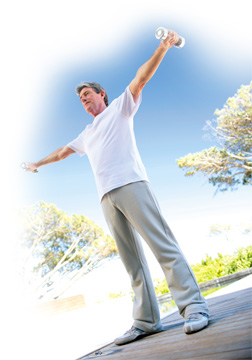Step 3: Stretch
The good news when it comes to stretching is that you don't need to spend as much time holding a stretched position as we previously thought. That's because we are often confused about the difference between stretching and warming up.
Warming up is about moving body parts slowly and through a full range of motion until your muscles get warmed up. This is the best thing to do before you start any exercise program. Research has shown that static stretching, holding a position for several seconds or more, can sometimes be responsible for increasing the risk of injury, not decreasing the risk.
For example, consider the hamstrings, the muscles on the back of our thigh. Most of you are probably familiar with hurdle stretches, or at least reaching down to touch your toes. Well, these positions can have negative effects on your back if you have any history of back pain or other health condition in which flexing forward is not recommended (osteoporosis, arthritis, low back pain, etc).
Instead, sit on a high chair and extend your leg out, hold for a second and then slowly bring it back in. This is called dynamic stretching, and for some people, it's easier to do. It also keeps your muscles moving, and warmed up. However, getting your muscles tested before increasing your fitness program is also recommended. Your chiropractic provider can assess which muscles are tight and which are weak. They can then prescribe the right type of exercise program to address these muscles.
 Step 4: Do Some Strength Training
Step 4: Do Some Strength Training
Surprisingly, most of my older patients believe that it may be too late to start a strength-training program. They feel that improvements are only seen in younger people. This is the biggest myth out there. In fact, researchers at University of Michigan Health System found that an adult can add 2.42 pounds of lean muscle and increase overall strength by 25 to 30 percent after 18 weeks of resistance training. This can occur well into the 80s and 90s, so it's never too late to start.
Start with your own body weight. Weight training doesn't mean joining a gym and lifting heavy weights. Start off by getting up from a seat, or slowly sitting down on a seat. This mimics a squat exercise and can be done safely without fear of falling. There are many exercises out there that can be done with your own body weight to start.
Progress to resistance elastic bands. After using your own body weight for a few weeks, start using elastic bands. Once you get comfortable with this, you can progress to using weights. However, consult your chiropractic provider before starting your weight-training program. They will be able to evaluate which areas need to be addressed through stretching or specific adjustments before you begin the program. Getting prepared will go a long way in preventing any injuries that could limit you from continuing.
Lifting lighter weights with more repetitions is just as effective. One of the biggest obstacles for my patients is that they think they will have to lift heavy weights to see any difference. This is not so. A recent research study by McMaster University found that muscles have the same benefits when someone uses lighter weights and repetitions of 20 to 25, rather than heavier weights and low repetitions, as often seen with bodybuilders. For the older population, strength training just two times per week can be effective.
Putting It All Together
Exercise doesn't have to be complicated to be effective. Walking can be done at any time. Strengthening can be done using your own body weight. Simply getting up from a chair and manually changing the television channel will go a long way in providing the additive effects of exercise. Take a small break during commercials to walk around or do some squats. Lack of creativity is the only thing that could hold you back.
As for my dad, he started the same way. He started off with a small walk after dinner. Then he got his feet evaluated for orthotics. That helped prevent shin splints or other types of pain that some people may experience when they start a new activity. Eventually, he was able to progress to hitting the gym on a regular basis. Not bad for an out-of-shape retiree who had triple bypass surgery.
Jasper Sidhu, DC, graduated from Canadian Memorial Chiropractic College in 1994 and opened the Downtown Injury Rehab Centre in Windsor, Ontario, incorporating vibration training into the rehabilitation part of his practice. He is vice president of clinical services for WAVE Manufacturing (www.wavexercise.com).

